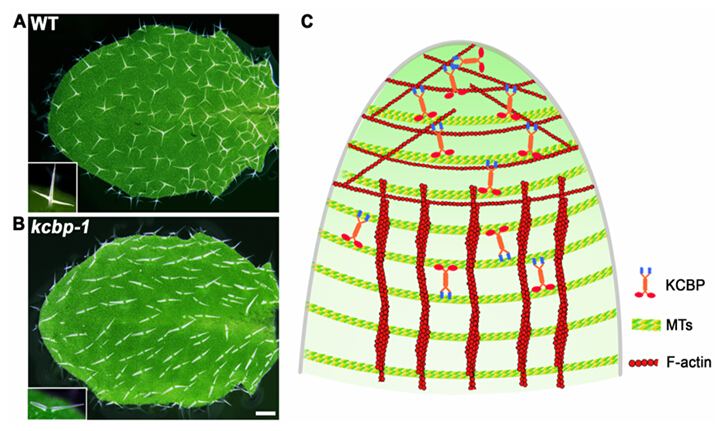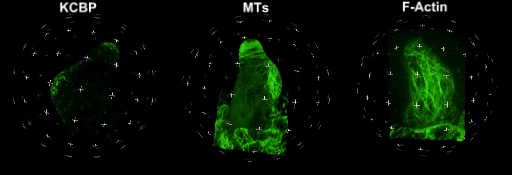The Arabidopsis thaliana leaf trichome, a single cell bearing three or four branches on top of a stalk (see Figure 1A), is a model system for investigating the mechanisms underlying cell shape control. KCBP, unique in the whole kinesin superfamily, has long been regarded as a chimera of kinesin and myosin. Loss of function in KCBP results in the zwichel trichome phenotype, which shows less-branched and contain shortened stalks and swollen, stunted branches (see Figure 1B). However, mechanisms of KCBP in trichome cell shape control remain unknown over a decade.
Prof. KONG Zhaosheng’s group in the Institute of Microbiology recently revealed that KCBP (Kinesin-like Calmodulin-Binding Protein), a plant-unique kinesin, acts as a central hub protein to integrate MTs and F-actin, and established the required cytoskeletal systems for trichome cell shaping. They found that KCBP contains a second MT-binding domain spanning the N-terminus and the MyTH4 region, and can also bind to F-actin via the FERM domain. During trichome morphogenesis, KCBP forms a cortical gradient, and highly accumulates at trichome branching sites and apical regions of elongating branches, thus integrating MTs and F-actin to assemble the specific cytoskeletal architecture for trichome branching, elongation, and tip sharpening (see the model in Figure 1).
Their findings build the direct link between the MT-based KCBP motor and the actin cytoskeleton, unravel the cellular basis controlling trichome cell shaping, and provide significant insights into the mechanisms of cytoskeletal regulation of cell shape determination.
The work was supported by the National Science Foundation of China and the grants from the State Key Laboratory of Plant Genomics.
These findings were published in eLife (http://dx.doi.org/10.7554/eLife.09351).
Key words: Trichome; Kinesin; Cytoskeleton

Figure 1. KCBP acts as a hub integrating MTs and actin filaments to control trichome cell morphogenesis. A. The wild-type trichomes. B. The kcbp-1 trichomes. C. A working model for KCBP in trichome cell shape control.

Video 1. Spatiotemporal distribution of KCBP, MTs and actin filaments are highlighted by 3-D reconstruction at the stage of primary branching.

Video 2. The 3-D reconstructed cortical MT configuration at the branch elongation stage.
Contact:
Prof. KONG Zhaosheng
E-mail: zskong@im.ac.cn